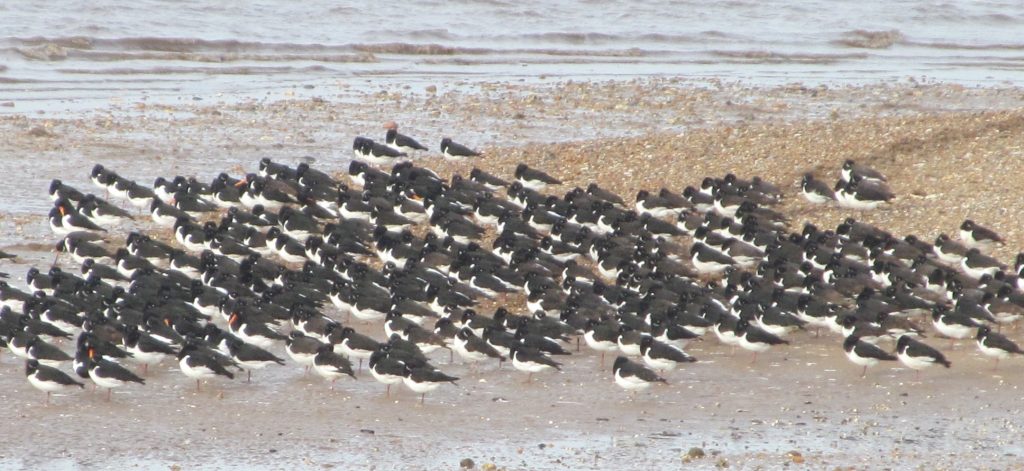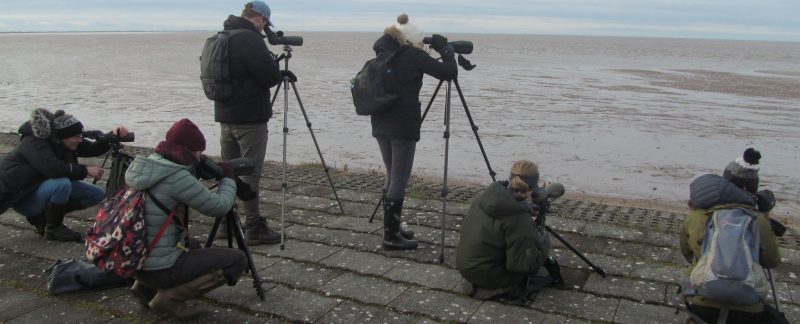Friday 25 January
Recces were done on Friday morning but there was poor visibility and although the birds had come up on the rising tide they had left before high water. So a further series of recces was planned for Saturday morning along with the resighting.
During the briefing, as there were a number of participants new to the group, Guy explained the background to our resighting activity. This enables us to get additional information, for instance survival data, on an annual basis and find out which fields and beaches Curlew are using. Reference was also made to driving with care, especially around Sandringham! More of that later…
Supper was baked potatoes with various fillings.
Saturday 26 January
The reccees/resighting covered Hunstanton and fields at Dersingham and the Royal Estate as well as the Heacham and Snettisham beaches and Snettisham Pits. We did well with Curlew resightings: 25 of 19 individuals.
Hunstanton was still looking promising for catching Turnstone. David and Lys looked at fields on the Royal Estate. A Landrover went by with what looked like a very smartly dressed shooting party. Not long after, while Lys was looking through a scope to read Curlew ring a police vehicle drew up and two officers got out. There followed a discussion about what we were doing and why as apparently there had been a photographer around. It was all friendly enough once we had established that it was a telescope and that a Curlew is a bird! Lys noticed that the police had a number of phones/radios tucked into the pockets of their jackets but David could see a pistol from his viewpoint in the car. When the police had left a beater started walking up the hedge and we knew the shoot was about to start. Not long after this, on the way home, we spotted a photographer at the already well-publicised road junction where the accident had occurred with HRH.
The team returned for breakfast and to decide on the rest of the day’s activities. Earlier in the week the weather had been looking really good for our weekend’s catching but as the field trip approached the forecast had deteriorated. With a predicted wind speed of 15 mph and gusts of up to 40 mph we made a decision in the afternoon to call off the evening’s planned mist netting. This meant that there was time to do a variety of house and garden maintenance tasks and some data and keeping cage work. Nigel and Lou went out to the beach to decide where to put the nets for Sunday’s catch as we would be setting in the dark after high water.
Meanwhile Skye was a happy bunny with so many possibilities of people to read to her. The stories featuring crocodiles went down particularly well!
The options for cannon netting on Sunday morning were: Royal Estate: 2,000 Golden Plover. Heacham NN: 50 Oystercatchers, 20 Grey Plover. Heacham South: 1500 birds; 400 scattered Curlew. A dog walker had put up the Oystercatcher but 250−300 remained and were later joined by 100+ others. A few Bar-tailed Godwit and Curlew were also roosting. Snettisham North: 3,000 Oystercatcher, 600 Barwit and 1,000 Knot spread out over 4−6 nets. Heacham South was the best option, the downside being it would be a late set.

Supper was tomato and vegetable pasta.
A setting party went out at 22:30 and set two nets. The set went well but the cars had to traverse very slippery ground and Chris needed a tow on the way out. The very tired team returned to base at 02:30.
Sunday 27 January
Everyone with a vehicle, except Nigel, accessed the beach from the Heacham end after the difficulties of the night before. Lou, Gary, Lizzie, Ryan and Ros, the trainee cannon-net licensees, were designated as long stops or twinklers. Guy was in charge of base camp. However when we arrived the birds were not where we had hoped. There was a flock of 2,000 Oystercatcher to the south and Curlew and gulls about a mile to the north. The mud had not exposed that much and with the strong onshore wind the Oystercatcher had gone south to shelter. It was clear that we had no catch option however it was an opportunity not to be wasted. So instead of a catch we did a test fire and practice net lift to give people the experience. We all went down to the beach and stood at the firing position. Guy gave a briefing regarding lifting the net. Nigel counted down and fired and we all ran to the net. All the action was videoed which could be useful for analysis later as well as jokes about running styles and speed! As expected, the net was held up by the strong wind.
We were joined on the beach by Lucy and James. This was James first visit to the Wash to participate in the ringing. He had been so excited that he had woken his mother up before the alarm to tell her that it was morning now and they could go the Wash. There were no birds to ring but James made the most of his visit by turning the breakfast table into a boat and later a submarine. He appointed Guy as captain and Jacquie in charge of a lifeboat when the boat hit an iceberg!
Some resighting was done on the way back from the beach for breakfast.
Resightings totals
| Friday | Saturday | Sunday | |
| Curlew | 8 | 25 (19 individuals) | 5 |
| Bar-tailed Godwit – WWRG | 2 | ||
| Bar-tailed Godwit – other | 2 | ||
| Turnstone | 1 | ||
| Oystercatcher – other | 1 | ||
| Total | 12 | 27 | 5 |

